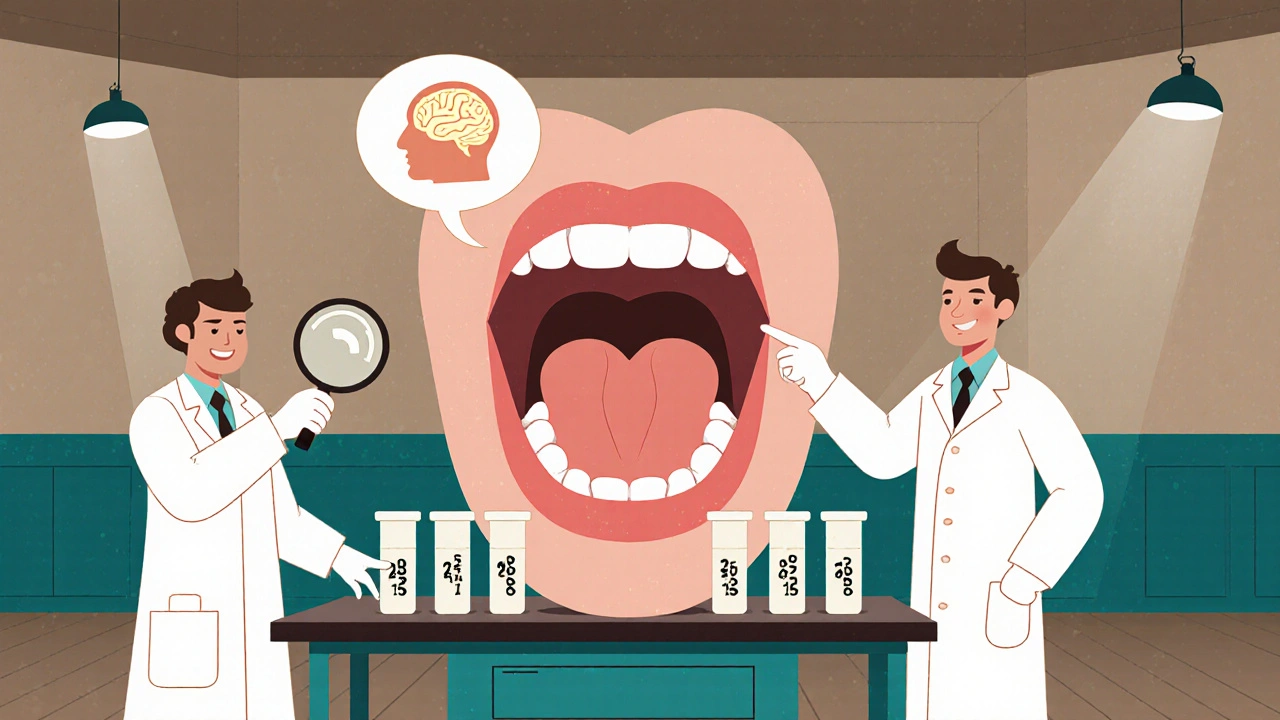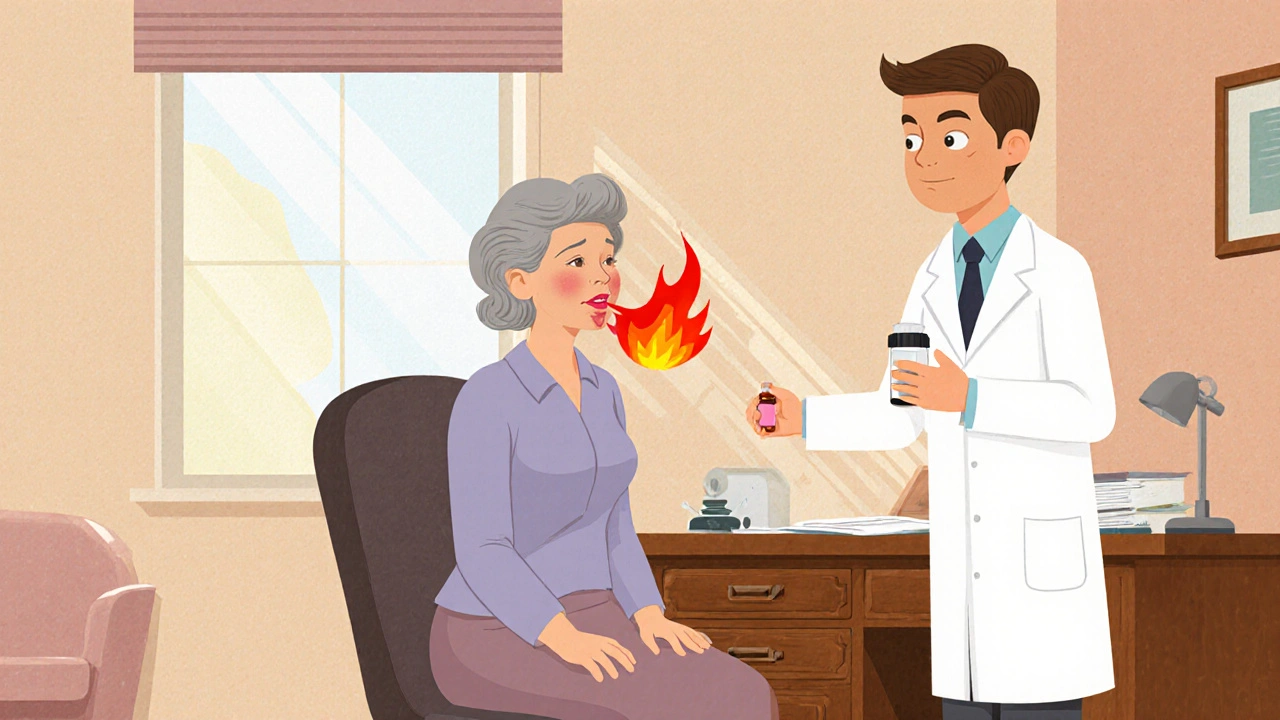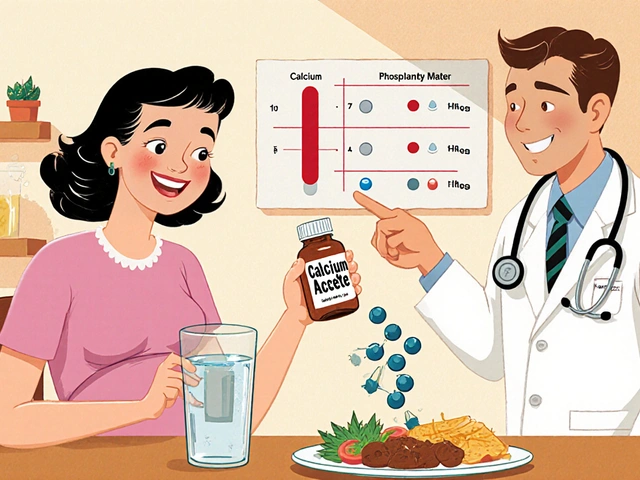Baclofen Dosage Calculator for Burning Mouth Syndrome
Dosing Calculator
How to Use This Tool
Use this calculator to estimate appropriate baclofen dosing for Burning Mouth Syndrome. Remember that baclofen is prescribed off-label for BMS and requires medical supervision.
Dosing Results
Enter your information and click "Calculate Dosing Schedule" to see your personalized dosing plan.
Many patients wonder if baclofen can ease the burning sensation that comes with Burning Mouth Syndrome (BMS). The short answer is: it might, but the evidence is mixed and the decision hinges on how the drug works, the typical dose used, and the side‑effect profile.
Key Takeaways
- Baclofen is a muscle relaxant that acts on GABA‑B receptors and is sometimes prescribed off‑label for BMS.
- Clinical data are limited; some small trials show modest pain relief, while others see no benefit.
- Typical dosing for BMS starts low (5mg three times daily) and may be increased to 20mg three times daily, depending on tolerance.
- Common side effects include drowsiness, dry mouth, and mild dizziness; serious adverse events are rare.
- Alternative therapies such as tricyclic antidepressants, capsaicin rinses, and cognitive‑behavioral strategies often serve as first‑line options.
What Is Burning Mouth Syndrome?
Burning Mouth Syndrome is a chronic pain condition characterized by a persistent burning or scalding sensation on the tongue, lips, palate, or whole mouth, without any visible clinical cause. It predominantly affects women over 50 and can last months to years, dramatically reducing quality of life.
The exact cause remains elusive, but researchers point to neuropathic mechanisms, hormonal changes, and altered salivary composition. Because no single trigger is identified, treatment is often empirical.
How Does Baclofen Work?
Baclofen is a muscle relaxant that works as an agonist at GABA‑B receptors in the central nervous system. By enhancing inhibitory signaling, it can dampen the hyper‑excitability of peripheral nerves that many scientists believe contributes to Neuropathic Pain. This theoretical link is why some clinicians try baclofen for BMS, even though the drug is officially approved for spasticity.
The drug’s effect on the oral mucosa is indirect; it does not alter saliva flow or taste buds, but the central modulation may reduce the perception of burning.
Evidence Landscape - Do Studies Support Its Use?
Published data are sparse. A 2019 pilot study from a university hospital in Spain enrolled 20 BMS patients and gave them baclofen 10mg three times daily for six weeks. Approximately 40% reported a noticeable drop in burning intensity measured by a visual analogue scale (VAS), while the rest saw no change.
Conversely, a 2021 double‑blind, placebo‑controlled Clinical Trial involving 45 participants failed to demonstrate a statistically significant difference between baclofen and placebo after eight weeks. The authors noted high variability in baseline pain scores and suggested that patient selection (e.g., those with clear neuropathic features) might explain the mixed results.
Regulatory bodies such as the Food and Drug Administration have not evaluated baclofen for BMS, so any use is off‑label and must be guided by a physician aware of the limited data.
Typical Dosage and Titration
When clinicians prescribe baclofen for BMS, they usually start low to avoid sedation. A common regimen looks like this:
- Day1‑3: 5mg three times daily.
- Day4‑7: Increase to 10mg three times daily if tolerated.
- Week2 onward: Adjust up to 20mg three times daily based on symptom relief and side‑effect profile.
The drug’s half‑life is about 2‑4hours, so divided dosing helps maintain steady plasma levels. Patients should avoid abrupt discontinuation after more than two weeks of therapy to prevent withdrawal symptoms such as increased spasticity or anxiety.
Side‑Effect Profile - What to Watch For
Baclofen is generally well‑tolerated, but several adverse effects are common enough to merit discussion:
- Drowsiness: The most frequent complaint, especially at higher doses.
- Dry Mouth: Ironically, this can worsen oral discomfort for BMS sufferers.
- Dizziness or Light‑headedness: May affect balance, particularly in older adults.
- GI upset: Nausea or constipation can appear, but they are usually mild.
Rarely, patients experience severe hypotension or allergic reactions. If any of these emerge, dose reduction or discontinuation is advised.
How Baclofen Stacks Up Against Other Treatments
Because the evidence base is thin, many clinicians reserve baclofen for patients who have not responded to first‑line options. Below is a quick comparison of the most commonly used BMS therapies.
| Treatment | Typical Dose / Regimen | Onset of Relief | Common Side Effects |
|---|---|---|---|
| Baclofen | 5‑20mg three times daily (off‑label) | 2‑6weeks (variable) | Drowsiness, dry mouth, dizziness |
| Clonazepam (benzodiazepine) | 0.25‑1mg nightly | 1‑2weeks | Dependence, sedation |
| Amitriptyline (tricyclic antidepressant) | 10‑25mg nightly | 3‑4weeks | Anticholinergic effects, weight gain |
| Capsaicin mouth rinse | 0.075% solution, 2‑3times daily | Immediate (burning sensation) then gradual relief | Transient oral burning |
Notice that baclofen’s onset is slower and its side‑effect burden is comparable to other systemic agents. For patients who cannot tolerate antidepressants or benzodiazepines, baclofen may be a viable alternative.

Practical Tips for Patients and Clinicians
If you and your doctor decide to try baclofen, keep these pointers in mind:
- Start at the lowest possible dose and titrate slowly.
- Take doses with meals to reduce gastrointestinal upset.
- Monitor pain scores daily using a simple 0‑10 scale; record any new symptoms.
- Stay hydrated to counteract dry mouth; sugar‑free gum can stimulate saliva flow.
- Schedule a follow‑up visit after 4weeks to assess efficacy and side‑effects.
- If you experience severe drowsiness, try taking the evening dose earlier or split it into smaller amounts.
Doctors should review the patient’s medication list for potential interactions. Baclofen can enhance the sedative effect of alcohol, antihistamines, and other central nervous system depressants.
When Not to Use Baclofen
Contra‑indications are rare but include uncontrolled epilepsy, severe renal impairment (because the drug is renally excreted), and a known hypersensitivity to baclofen. Pregnant or breastfeeding individuals should avoid it unless the benefits clearly outweigh the risks.
Future Directions - Ongoing Research
Several trials are slated to begin in 2026, aiming to clarify baclofen’s role in neuropathic oral pain. One multi‑center study plans to stratify participants based on quantitative sensory testing (QST) to identify a subgroup that might respond best. If those results turn out positive, baclofen could move from an off‑label curiosity to a formally recommended option.
Frequently Asked Questions
Is baclofen approved for treating Burning Mouth Syndrome?
No. Baclofen is FDA‑approved for spasticity, not for BMS. Its use in oral burning pain is off‑label and based on limited clinical evidence.
How long should I try baclofen before deciding if it works?
Most clinicians recommend a minimum of 4-6weeks at a stable dose. Pain relief, if it occurs, usually appears within that window.
Can baclofen be combined with other BMS treatments?
Yes, but only under medical supervision. Combining baclofen with other CNS depressants (e.g., clonazepam) can increase sedation, while pairing it with topical agents like capsaicin is generally safe.
What should I do if I experience severe dry mouth?
Increase water intake, chew sugar‑free gum, or discuss a dose reduction with your doctor. In some cases, a saliva substitute or pilocarpine can help.
Is there a risk of dependence on baclofen?
Physical dependence is rare with baclofen when used at BMS doses, but abrupt cessation after prolonged use can cause withdrawal symptoms such as heightened anxiety or muscle stiffness. Tapering is advisable.






Comments
Baclofen's minimal pain relief isn’t worth the drowsiness it brings.
Wow!!! I can’t believe people still swear by this muscle relaxant!!! It’s like hopping on a roller coaster of side effects-drowsy, dry mouth, dizziness-who needs that??! And the evidence? A handful of tiny studies that can’t even agree on anything!!! It’s a gamble, folks!!!
It’s true it can help a few but the trade‑off often outweighs the gain.
Stop treating baclofen like a miracle cure. It’s a muscle relaxant, not a magic bullet for oral pain. If you’re already sleepy, adding more sedation is reckless.
Hey there! If you’re considering it, start low and watch how you feel. 🙂 A gentle approach can spare you the worst of the drowsiness and you can always adjust. 👍
Just a heads‑up, many folks in the UK prefer trying capsaicin rinses first – they’re cheap and don’t make you nap all day.
Listen up, America! We deserve treatments that actually work-not half‑baked off‑label experiments!!! If baclofen gives you a foggy brain, it’s a betrayal of our right to stay alert and productive!!! Push back against the pharma push!!
Respected colleagues, it is imperative to adopt a methodical titration schedule when employing baclofen for BMS. Commence with 5 mg three times daily, assess tolerability after a week, and only then contemplate escalation. This disciplined approach safeguards against undue sedation while permitting a measured evaluation of therapeutic benefit.
Thanks for the clear steps! I’ll make sure to track pain scores daily and let my doc know if the dry mouth gets out of hand. Let’s keep each other posted.
🚨Wake up!🚨 The pharma giants are hiding the full side‑effect profile behind “off‑label” jargon. Every dose is a data point in their secret trial, and we’re the unwitting subjects. 🤔 Stay alert, question the “evidence,” and demand transparency! 💡
Honestly, if you read the original studies you’ll see the statistics are flimsy at best. Most patients report no change, yet the hype persists because of marketing hype, not science.
From a clinical perspective, the GABA‑B agonism offers a plausible mechanism, but without robust RCTs the risk‑benefit ratio stays uncertain.
Let’s be real-basing treatment on a 20‑patient pilot is like judging a symphony by a single note. The literary elite of pain management demand more rigor before endorsing such a pedestrian approach.
In the grand tapestry of medical therapeutics, the allure of off‑label applications reflects a deeper philosophical tension between empirical rigor and the human yearning for relief. When clinicians reach for baclofen in the context of Burning Mouth Syndrome, they are, in effect, navigating a liminal space where neuropharmacology intersects with the phenomenology of pain. The GABA‑B receptor agonism, while mechanistically sound, does not guarantee a translational cascade that culminates in subjective comfort. Moreover, the heterogeneity of BMS-spanning neuropathic, hormonal, and psychogenic dimensions-mandates a nuanced appreciation of patient sub‑phenotypes.
To that end, a judicious titration protocol is not merely a safety measure but a philosophical commitment to patient autonomy. Initiating therapy at 5 mg thrice daily respects the principle of “primum non nocere,” allowing the nervous system to adapt without abrupt perturbation. Incremental escalation, contingent upon tolerability, embodies the Aristotelian golden mean: neither excess nor deficiency.
Nevertheless, the empirical literature remains sparse, a mosaic of small pilots and underpowered trials. The 2019 Spanish study, with its modest 20 participants, suggests a 40 % response rate, yet the confidence intervals are broad, rendering the estimate fragile. Conversely, the 2021 double‑blind trial, though larger, failed to achieve statistical significance, highlighting the volatility of outcomes across cohorts.
Given this equivocal evidence, clinicians must integrate Bayesian reasoning, weighting prior beliefs against emerging data. In practice, this translates to a shared decision‑making process, wherein patients are apprised of potential benefits-namely, modest pain attenuation-and risks, including sedation, dry mouth, and the specter of withdrawal upon abrupt cessation.
Finally, the future of baclofen in BMS may hinge upon stratified medicine. Ongoing trials that employ quantitative sensory testing to delineate responder phenotypes could illuminate a subset of patients for whom GABA‑B modulation is particularly efficacious. Until such data materialize, the prescription of baclofen should remain a calibrated gamble, reserved for those who have exhausted first‑line modalities and who are fully cognizant of the balance between hope and uncertainty.